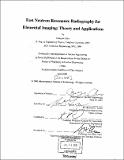Fast neutron resonance radiography for element imaging : theory and applications
Author(s)
Chen, Gongyin, 1968-
DownloadFull printable version (13.72Mb)
Other Contributors
Massachusetts Institute of Technology. Dept. of Nuclear Engineering.
Advisor
Richard C. Lanza.
Terms of use
Metadata
Show full item recordAbstract
Fast Neutron Resonance Radiography (NRR) has been devised as an elemental imaging method, with immediate applications to detecting explosives and drugs in passenger suitcases. In the NRR method, the 2-D elemental mapping of hydrogen, carbon, nitrogen, oxygen and the sum of other elements are obtained from fast neutron radiographic images taken at different neutron energies chosen to cover the resonance cross section features of one or more elements. A radiographic image provides the 2-D mapping of the sum of elemental contents (weighted by the attenuation coefficients) and transmission measurements taken at different neutron energies form a set of linear equations, which can be solved to map individual elemental contents. Explosives and drugs can be identified by their characteristic elemental composition. The object-detector assembly rotates around the neutron source and different energy (2-6 MeV) neutrons can be obtained at different angles from a DD neutron source. A fixed-energy RFQ (2.3 MeV deuteron energy) with a thick target (0.4-0.8 MeV) can be used to generate fast neutrons. The physics of image formation in fast neutron radiography has been studied and a thick (4 cm) plastic scintillator has been recommended as the neutron detector. (cont.) Variance-checking median filters have been recommended for removing sparkles in the digital image and the direct Householder Transform has been used to solve the ill-conditioned Least-Squares problem. Source shielding for 2x109 neutrons/second has been suggested. Experiments and simulation have proven NRR to be effective. Explosives can be identified with their high nitrogen and oxygen content and drugs with their high C/O ratio. With a 10 [mu]A deuteron current and 6 atmosphere-cm D2 gas target, total imaging time for each piece is expected to be 1-2 minutes. Because multiple objects can be inspected at the same time, it is possible to meet the FAA standard of 8 seconds per piece. Spatial resolution of the image is estimated to be -7.5 mm.
Description
Thesis (Ph. D.)--Massachusetts Institute of Technology, Dept. of Nuclear Engineering, 2001. Includes bibliographical references (p. 140-143).
Date issued
2001Department
Massachusetts Institute of Technology. Department of Nuclear Engineering; Massachusetts Institute of Technology. Department of Nuclear Science and EngineeringPublisher
Massachusetts Institute of Technology
Keywords
Nuclear Engineering.